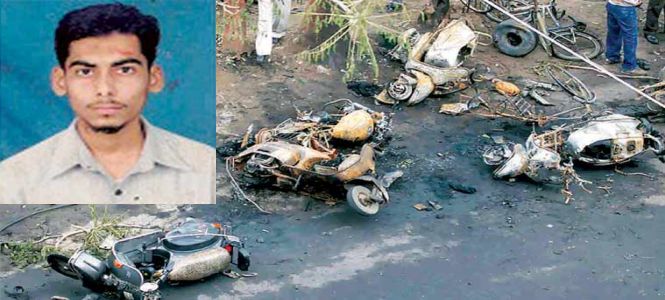
He was wanted in the 2008 Ahmedabad blasts that killed 56. He was wanted in the 2008 Ahmedabad blasts that killed 56.
Five years after he allegedly parked an IED-strapped bicycle in Ahmedabad’s Diamond Market on July 26, 2008, former SIMI activist Alamzeb Afridi walked into a South Bengaluru police station and lodged a complaint of assault against his employer. The police provided him relief by arresting the accused.
They had no clue then that he was one of India’s most wanted, accused of killing 56 people in the 2008 Ahmedabad blasts — until last month, when Afridi was arrested by NIA in connection with the Bengaluru blast of 2014.
The interrogation of Afridi has shown how a 2002 Gujarat riots victim morphed from being a struggling student “who spoke good Sanskrit” in 2004 to a dreaded terrorist and a potential Islamic State (IS) operative in 2016, allegedly playing a key role in two terror strikes.
And how, in between, he stayed under the radar by acquiring new identities — as a soil contractor in UP, security guard in Maharashtra, sweet shop attendant in Haryana, X-ray technician in Gujarat and AC mechanic in Bengaluru.
“Had he not committed another terror act, he would have probably never been caught,” said an NIA investigator.
In Bangalore, for instance, he was known as Mohammed Rafique, a popular AC mechanic with an LIC policy, an Aadhar card and an SBI bank account holding Rs 70,000. So popular, he told investigators, that his employer allegedly hired 10 men to assault him in 2013 for taking away his business.
He had also acquired a bike, a smartphone and a large circle of friends, one of whom got his sister married to him in 2015. But this was also the time, he told investigators, that he began to surf the net for radical Islamic literature and videos.
By 2014, Afridi had opened at least 40 Facebook and 24 Gmail accounts to interact on radical Islam, anti-Semitism and Islamic State (IS). Sources said he also found a handler, who instigated him to commit arson at the Israeli visa centre in Bengaluru on November 29, 2015, and tied up with Junud al Khilafa-e-Hind, a self-appointed IS affiliate whose members are in NIA custody.
Born in September 1986, to a livestock fodder trading father in Ahmedabad’s Juhapura, Afridi studied till Class 10 in Sunflower School where he learnt Sanskrit, Urdu and Arabic, he told investigators. He continued his studies despite his father’s incarceration following an incident of stabbing in 1993.
The turning point, said sources, came when he was about to appear for the Class 10 exams and the Gujarat riots broke out. “I lost three members of my extended family in the Naroda-Patiya massacre. The families of my maternal uncle were badly affected,” Afridi told interrogators.
In 2004, Afridi failed in his Class 12 exams after moving to Falahe Daren School. And, as the atmosphere around him began changing, he quit studies and joined the Jamaat-e-Islami, reading radical literature, listening to preacher Zakir Naik and reading Tahreek-e-Millat, a magazine brought out by SIMI, by then banned.
Sources said Afridi first came in contact with SIMI members such as Arif Kagzi, Javed Sheikh and Samshuddin at the local library and later, with the outfit’s militant leaders Safdar Nagori and Abdus Subhan Qureshi alias Tauqeer, who is wanted in several blast cases.
He also claimed to have attended a terror training camp in Hallol near Vadodara in 2007, where he was shown videos on Taliban, Al Qaeda and Chechnya terrorists, and “political classes” where Bajrang Dal and VHP were discussed.
In between, he told sleuths, he worked as an attendant in a PCO and a hospital, before his friend Qayamuddin Kapadia and Tauqeer gave him Rs 6,000 to buy bicycles. He said that he parked the cycles, strapped with IEDs, at Diamond Market.
Immediately after the blasts, Afridi fled to Farrukhabad to live with a relative even as he cut off all ties with his SIMI colleagues. But as his name popped up in the media following a string of arrests in Mumbai and an encounter in Delhi, his parents asked him to surrender. He did not agree but had to return to Gujarat, after the relative asked him to leave, and stayed away from his parents.
Afridi told investigators that he knew he had to be constantly on the move to avoid detection. So, he said, he returned to UP to work as a soil contractor in Kanpur; moved to Amravati in Maharashtra to work as a security guard in a market; and on to Shahjahanpur in Haryana to work at a highway dhaba.
According to sources, it was when he moved to Mewat to work in a sweet shop that he came in contact with people linked to Bangalore.
But then, he told sleuths, as life acquired legitimacy and comfort, Afridi went back to searching for radical Islam — this time, interacting with pro-IS youth through facebook, Kick messenger and justpaste.it on his smartphone.
In October 2014, he met a man named Abdul Khan, and after discussing an incident related to the Babri demolition case, started inquiring about ways to go to Syria to join IS. Khan, the “handler”, asked him to first “work for the interests of Islam in India” and taught him how to make a bomb.
Then, in February 2015, Afridi came in contact with JKH operative Nafees Khan and expressed his desire to travel to Syria. Nafees Khan, whom Afridi had met twice earlier, told him this would take time. But before that, both were arrested.